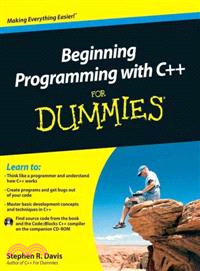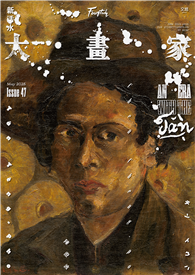| FindBook |
有 1 項符合
BEGINNING PROGRAMMING WITH C++ FOR DUMMIES的圖書 |
 |
BEGINNING PROGRAMMING WITH C++ FOR DUMMIES 作者:Davis,Stephen R. 出版社:John Wiley & Sons Inc 出版日期:2010-08-16 語言:英文 規格:平裝 / 430頁 / 2.5 x 19.1 x 23.5 cm / 普通級 |
| 圖書館借閱 |
| 國家圖書館 | 全國圖書書目資訊網 | 國立公共資訊圖書館 | 電子書服務平台 | MetaCat 跨館整合查詢 |
| 臺北市立圖書館 | 新北市立圖書館 | 基隆市公共圖書館 | 桃園市立圖書館 | 新竹縣公共圖書館 |
| 苗栗縣立圖書館 | 臺中市立圖書館 | 彰化縣公共圖書館 | 南投縣文化局 | 雲林縣公共圖書館 |
| 嘉義縣圖書館 | 臺南市立圖書館 | 高雄市立圖書館 | 屏東縣公共圖書館 | 宜蘭縣公共圖書館 |
| 花蓮縣文化局 | 臺東縣文化處 |
|
|
- 圖書簡介
An ideal starting point to get a strong grasp of the fundamentals of C++
C++ is an object-oriented programming language commonly adopted by would-be programmers. This book explores the basic development concepts and techniques of C++ and explains the "how" and "why" of C++ programming from the ground up.
You'll discover what goes into creating a program, as well as how to put the various pieces together, deal with standard programming challenges, handle debugging, and make it all work.
Details the basics of C++ programming and explores the "how" and "why" of this object-oriented language
Addresses the various components that go into creating a program with C++
Walks you through common challenges of C++ programming
Assuming no prior experience, Beginning Programming with C++ For Dummies is a fun and friendly guide to learning the C++ language.
Note: CD-ROM/DVD and other supplementary materials are not included as part of eBook file. - 作者簡介
Stephen R. Davis is a programmer and the bestselling author of several books on the C languages, including C# For Dummies, C++ Weekend Crash Course, and all editions of C++ For Dummies. He currently works for L-3 Communications in the area of Homeland Defense.
- 目次
Introduction.
Part I: Let's Get Started.
Chapter 1: What Is a Program?
Chapter 2: Installing Code::Blocks.
Chapter 3: Writing Your First Program.
Part II: Writing a Program: Decisions, Decisions.
Chapter 4: Integer Expressions.
Chapter 5: Character Expressions.
Chapter 6: if I Could Make My Own Decisions.
Chapter 7: Switching Paths.
Chapter 8: Debugging Your Programs, Part 1.
Part III: Becoming a Functional Programmer.
Chapter 9: while Running in Circles.
Chapter 10: Looping for the Fun of It.
Chapter 11: Functions, I Declare!
Chapter 12: Dividing Programs into Modules.
Chapter 13: Debugging Your Programs, Part 2.
Part IV: Data Structures.
Chapter 14: Other Numerical Variable Types.
Chapter 15: Arrays.
Chapter 16: Arrays with Character.
Chapter 17: Pointing the Way to C++ Pointers.
Chapter 18: Taking a Second Look at C++ Pointers.
Chapter 19: Programming with Class.
Chapter 20: Debugging Your Programs, Part 3.
Part V: Object-Oriented Programming.
Chapter 21: What Is Object-Oriented Programming?
Chapter 22: Structured Play: Making Classes Do Things.
Chapter 23: Pointers to Objects.
Chapter 24: Do Not Disturb: Protected Members.
Chapter 25: Getting Objects Off to a Good Start.
Chapter 26: Making Constructive Arguments.
Chapter 27: Coping with the Copy Constructor.
Part VI: Advanced Strokes.
Chapter 28: Inheriting a Class.
Chapter 29: Are Virtual Functions for Real?
Chapter 30: Overloading Assignment Operators.
Chapter 31: Performing Streaming I/O.
Chapter 32: I Take Exception!
Part VII: The Part of Tens.
Chapter 33: Ten Ways to Avoid Bugs.
Chapter 34: Ten Features Not Covered in This Book.
Appendix: About the CD.
Index.
|











